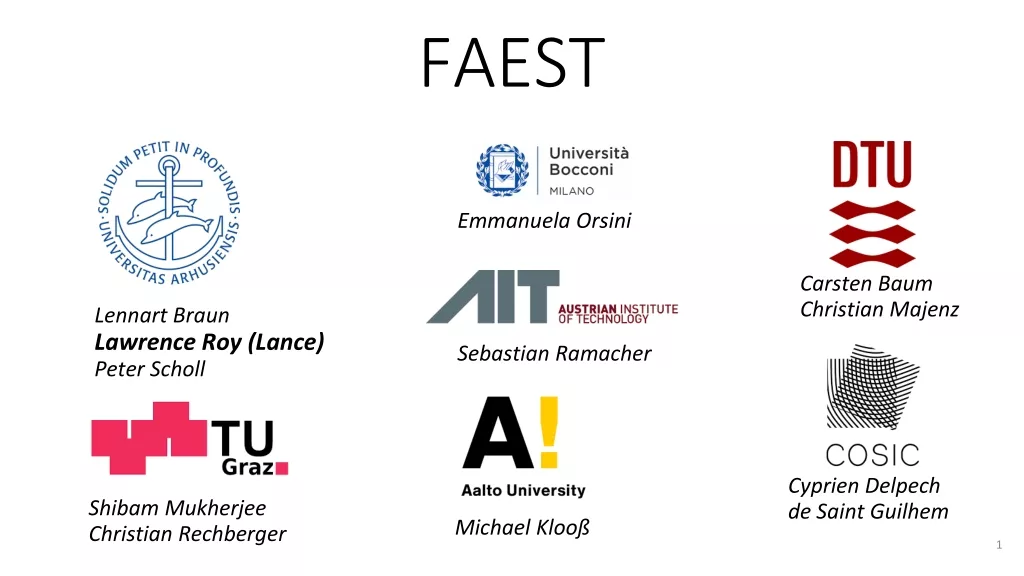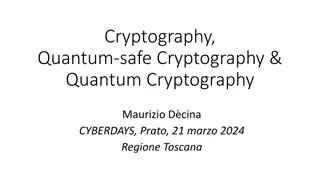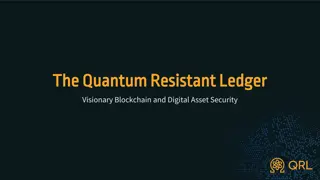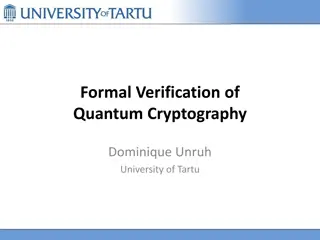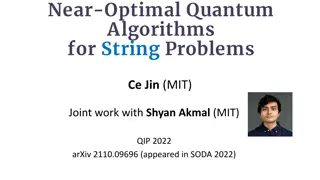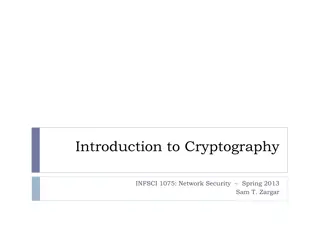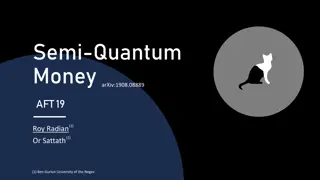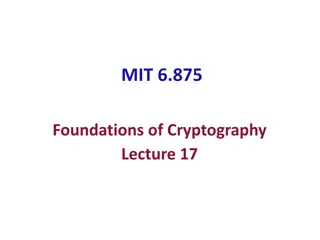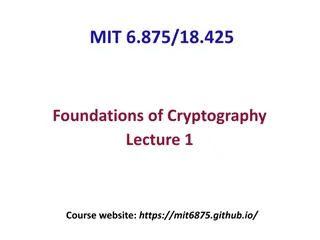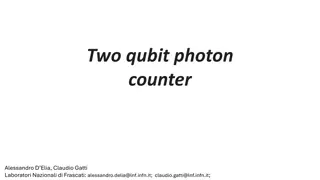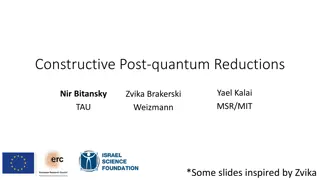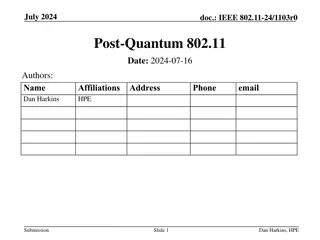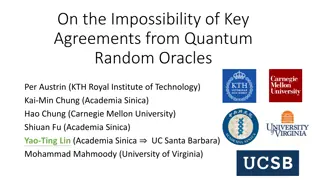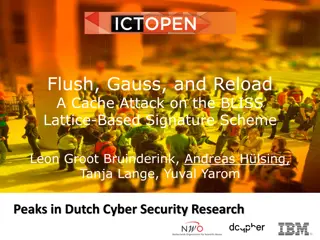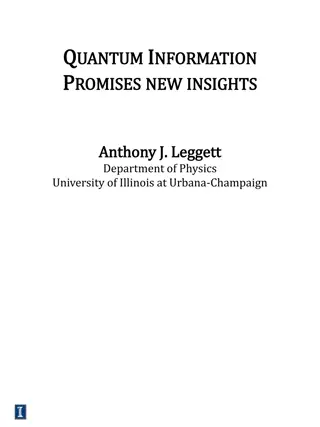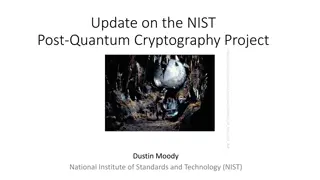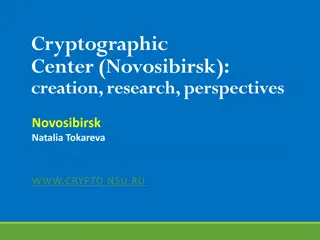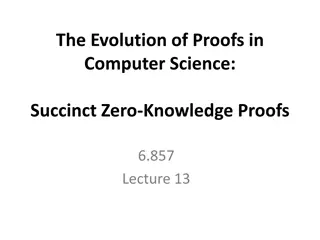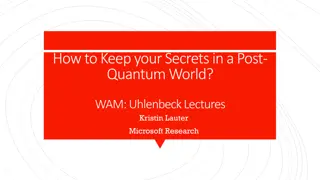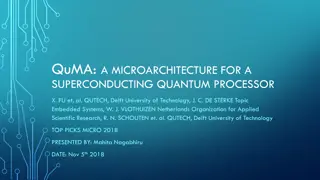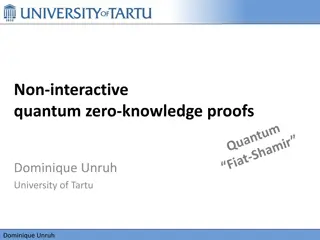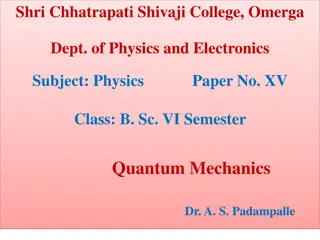Post-Quantum Cryptography Security Proofs and Models Overview
Explore the various aspects of post-quantum cryptography security, including evaluation criteria, building public key cryptography (PKC) systems, security proofs, digital signatures, and reduction problems. Dive into topics such as performance, cryptanalysis, provable security, standard models, existential unforgeability, and reduction implications.
Download Presentation

Please find below an Image/Link to download the presentation.
The content on the website is provided AS IS for your information and personal use only. It may not be sold, licensed, or shared on other websites without obtaining consent from the author. Download presentation by click this link. If you encounter any issues during the download, it is possible that the publisher has removed the file from their server.
E N D
Presentation Transcript
(Post-quantum) cryptography Security models, proofs and generic transforms Andreas H lsing Eindhoven University of Technology Executive School on Post-Quantum Cryptography July 2019, TU Eindhoven
Evaluation criteria for crypto Performance Speed Size Cryptanalysis Maturity, quantity & quality Are the relevant problems analyzed Provable security Standard model vs. (Q)ROM Tight vs non-tight reduction Implementation security Possibility / availability of protected implementations Picture: By Rizkyharis - Own work, CC BY-SA 4.0, https://commons.wikimedia.org/w/index.php?curid=52757933 01/07/2019 https://huelsing.net 2
How to build PKC (Computationally) hard problem RSA QR Proof Problem hard Scheme secure DL DDH PKC Scheme RSA- OAEP ECDSA DH- KE 01/07/2019 https://huelsing.net 3
Security proofs (for the example of digital signatures)
Digital Signature Source: http://hari-cio-8a.blog.ugm.ac.id/files/2013/03/DSA.jpg 01/07/2019 https://huelsing.net 5
Security proofs Four dimensions What are we looking at? Signature scheme? MAC? Key evolving signatures... Determines functionality What do we want to prove? EU-CMA, SU-CMA, FS-EU-CMA, EU-RMA... Determines security guarantee In which model can we give the proof? Standard model vs ROM vs QROM Heuristic model or not Can we get a tight proof? Reduction loss Does proof say something for concrete parameters 01/07/2019 https://huelsing.net 6
Existential unforgeability under adaptive chosen message attacks SK PK, 1n ?? Mi SIGN ( i, Mi) ( *, M*) Success if M* Mi, i [0,q] and Verify(pk, *,M*) = Accept 01/07/2019 https://huelsing.net 7
Reduction Problem PK, 1n Transform Problem ?? Mi Implement SIGN SIGN ( i, Mi) Solution ( *, M*) Extract Solution 01/07/2019 https://huelsing.net 8
Reduction: Implications To prove: If ? can break [security] of [scheme] in time ? with probability ? then ?? can solve [problem] in time ?1(?) with probability ?2(?). Implications: 1. If ?1,?2 are polynomial functions (non-tight): If [problem] is hard, [scheme] is secure. 2. If ?1,?2 are close to identity (tight): The [scheme] is as hard to break as the problem. 01/07/2019 https://huelsing.net 9
Standard model vs. idealized model Standard model: Assume building block has property P (e.g., collision resistance). Use property in reduction. Idealized model: Assume a building block behaves perfectly (e.g. hash function behaves like truely random function). Replace building block by an oracle in reduction. 01/07/2019 https://huelsing.net 10
Random Oracle Model (ROM) Idealized Model Perfectly Random Function Mj H(Mj) Mj H(Mj) RO 01/07/2019 https://huelsing.net 11
How to implement RO? (In theory) Lazy Sampling : 1. Keep list of (??,??) 2. Given ??, search for ??= ?? 3. If ??= ??exists, return ?? 4. Else sample new ? from Range, using uniform distribution 5. Add (??,?) to table 6. Return ? RO 01/07/2019 https://huelsing.net 12
ROM security Take scheme that uses cryptographic hash For proof, replace hash by RO Different flavors: Random function vs. Programmable RO 01/07/2019 https://huelsing.net 13
Programmable RO Problem PK, 1n Transform Problem ?? Mi Mj Implement SIGN SIGN ( i, Mi) H(Mj) RO Solution ( *, M*) Extract Solution 01/07/2019 https://huelsing.net 14
Programmable RO Problem PK, 1n Transform Problem ?? Mi Mj Implement SIGN SIGN ( i, Mi) H(Mj) simulated RO Solution ( *, M*) Extract Solution 01/07/2019 https://huelsing.net 15
ROM security Take scheme that uses cryptographic hash For proof, replace hash by RO Different flavors: Random function vs. Programmable RO Heuristic security argument Allows to verify construction Worked for Natural schemes so far However: Artificial counter examples exist! Random oracles do not exist! 01/07/2019 https://huelsing.net 16
Quantum security worlds [Gagliardoni 17]
QS0: Classical security 01010101110110 11010101 01110110 11010101 01110110 11000101 00010110 01/07/2019 https://huelsing.net 18
QS1: Post-quantum security 01010101110110 11010101 01110110 11010101 01110110 0 1 0 1 0 1 0 0 1 1 1 1 1 0 01/07/2019 https://huelsing.net 19
QS1: Post-quantum security Adversary can run local quantum computations Adversary cannot communicate with honest parties using quantum states! Local interfaces & oracles that do not contain secret information: Quantum access Remote interfaces & secretly keyed oracles: Classical access 01/07/2019 https://huelsing.net 20
QS2: Quantum security 0 0 0 0 1 1 0 1 0 1 1 1 1 1 0 1 0 1 0 1 0 0 1 1 1 1 1 0 1 0 1 0 1 0 0 1 1 1 1 1 0 0 0 1 0 1 0 1 0 0 1 1 1 1 1 0 01/07/2019 https://huelsing.net 21
QS2: Quantum security Adversary can run local quantum computations Adversary can communicate with honest parties using quantum states! Local interfaces & oracles that do not contain secret information: Quantum access Remote interfaces & secretly keyed oracles: Quantum access This assumes a world where users have quantum computers 01/07/2019 https://huelsing.net 22
We care about QS1 for practical applications in the foreseeable future!!! 01/07/2019 https://huelsing.net 23
QS1: Post-quantum security Adversary can run local quantum computations Adversary cannot communicate with honest parties using quantum states! Local interfaces & oracles that do not contain secret information: Quantum access Remote interfaces & secretly keyed oracles: Classical access What happens in ROM? 01/07/2019 https://huelsing.net 24
Quantum-accessible ROM (QROM) Problem PK, 1n Transform Problem ?? Mi ?? Implement SIGN SIGN ( i, Mi) ?(??) QRO Solution ( *, M*) Extract Solution 01/07/2019 https://huelsing.net 25
The QROM ROM lives in QS0. Wrong model for post- quantum security! QROM: Adaption of ROM for QS1 post-quantum security. Proofs in QROM more involved as looking at queries disturbes adversary -> complicates adaptive behavior Only weak separation known (using squareroot speed-up of Grover) 01/07/2019 https://huelsing.net 26
Generic transforms (for the example of KEM construction)
How to build PKC (Computationally) hard problem RSA QR Proof Problem hard Scheme secure DL DDH Simple cryptographic scheme PKC Scheme RSA- OAEP ECDSA DH- KE 01/07/2019 https://huelsing.net 28
Public key encryption (PKE) plaintext plaintext SKE.Dec PKE.Enc Bob s pk Bob s sk 01/07/2019 https://huelsing.net 29
Public key encryption (PKE) Gen 1?: is a probabilistic algorithm that outputs a key pair ??,?? . Enc(??,?): is a possibly probabilistic algorithm that on input of a public key and a message outputs a ciphertext ? = Enc??(?). Dec(??,?): is a deterministic algorithm that on input of a secret key and a ciphertext outputs a plaintext ? = Dec??(?). Correctness: ? ?, ??,?? ??? 1? Dec??(Enc??(?)) = ? : 01/07/2019 https://huelsing.net 30
Weak passiv security (OW-CPA) 01/07/2019 https://huelsing.net 31
Strong passiv security (IND-CPA) 01/07/2019 https://huelsing.net 32
Active security (IND-CCA) IND-CPA + access to decryption oracle Decryption query for challenge ciphertext forbidden Necessary if scheme gets used with non-ephemeral keys! In practice, binary response (valid / invalid ciphertext) can be sufficient for attack. 01/07/2019 https://huelsing.net 33
Hybrid encryption symmetric session key plaintext plaintext SKE.Dec SKE.Enc PKE.Enc PKE.Dec Bob s pk Bob s sk 01/07/2019 https://huelsing.net 34
Key encapsulation (KEM) symmetric session key plaintext plaintext SKE.Dec SKE.Enc KEM.Enc KEM.Dec Bob s pk Bob s sk 01/07/2019 https://huelsing.net 35
Key encapsulation (KEM) Gen 1?: is a probabilistic algorithm that outputs a key pair ??,?? . Enc(??,?): is a possibly probabilistic algorithm that on input of a public key outputs a session key ? and an encapsulation (?,?) = Enc??(). Dec(??,?): is a deterministic algorithm that on input of a secret key and an encapsulation outputs a session key ? = Dec??(?). Correctness: ??,?? ??? 1? ?,? = Enc?? : ? = Dec??(?) 01/07/2019 https://huelsing.net 36
IND security models for KEM IND: Given a pair (c, k) decide if c is encapsulation of k or random CPA: Adversary gets pk and can hence generat encapsulations CCA: Adversary gets access to decapsulation oracle (which returns for challenge encapsulation) 01/07/2019 https://huelsing.net 37
IND-CPA PKE -> IND-CCA KEM Generic transform essentially going back to Fujisaki and Okamoto, CRYPTO 99 IND-CPA PKE OW-CPA dPKE IND-CCA KEM 01/07/2019 https://huelsing.net 38
IND-CPA PKE -> OW-CPA dPKE T-Transform [HHK17] Start from IND-CPA secure PKE = (Gen, Enc, Dec) with probabilistic Enc and a hash function H. Build OW-CPA secure PKE = (Gen, Enc , Dec) = T(PKE, H) with deterministic Enc : Enc ??(m) = Enc??(?;H ? ) Randomness Tight security reduction in ROM Non-tight security reduction in QROM 01/07/2019 https://huelsing.net 39
OW-CPA dPKE -> IND-CCA KEM ? -Transform [HHK17] Start from OW-CPA secure dPKE P = (Gen, Enc, Dec), PRF F, and hash function H. Build IND-CCA secure KEM ? P,F,H : 01/07/2019 https://huelsing.net 40
Summary Security proof security proof Only tight proofs say something about the security of parameters Only standard model & QROM proofs say something about post-quantum security Generic transforms can save you a lot of work Sufficient to construct OW-CPA dPKE for IND-CCA KEM with tight QROM proof Sufficient to construct IND-CPA PKE for IND-CCA KEM with QROM proof 01/07/2019 https://huelsing.net 41
Thank you! Questions? 01/07/2019 https://huelsing.net 42





